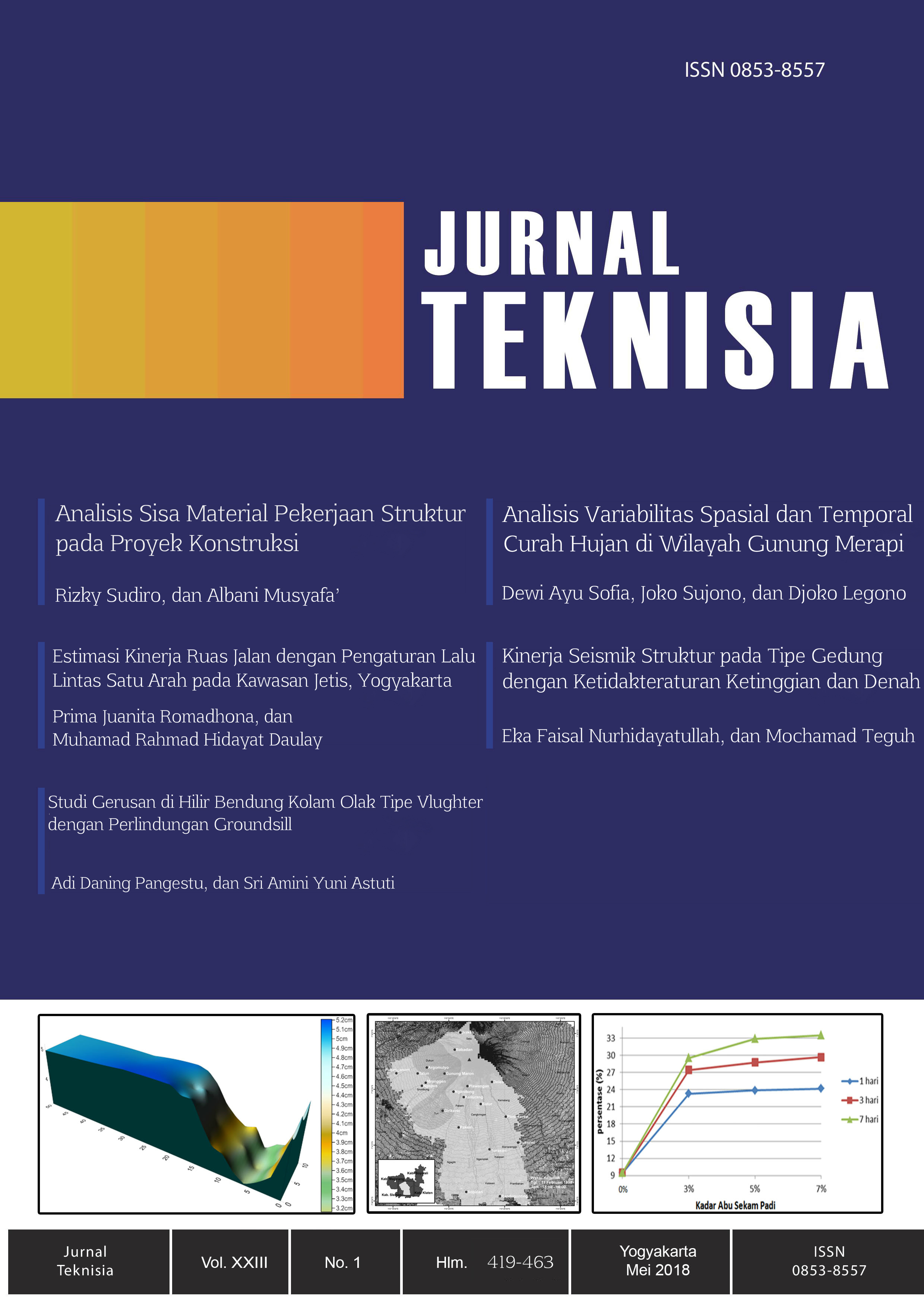Main Article Content
Abstract
Keywords
Article Details
Under the following term:
-
Attribution — You must give appropriate credit, provide a link to the license, and indicate if changes were made. You may do so in any reasonable manner, but not in any way that suggests the licensor endorses you or your use.
-
ShareAlike — If you remix, transform, or build upon the material, you must distribute your contributions under the same license as the original.
- No additional restrictions — You may not apply legal terms or technological measures that legally restrict others from doing anything the license permits.
References
- Alibaggio, M.A., Kurnia, I.R.K, Ismiyati, Setiadji, B.H, 2017, Analisis Kinerja dan Nilai Manfaat Diberlakukannya Sistem Satu Arah (Studi Kasus Simpang Lima Semarang), Jurnal Karya Teknik Sipil, Volume 6, Nomor 3, 148 - 160
- Bolla, M.E., Messah, Y.A & Johanes, L, 2015, Kajian Penerapan Rekayasa Lalu Lintas Sistem Satu Arah Pada Simpang Tiga Straat A Kota Kupang, Jurnal Teknik Sipil, Volume 4, Nomor 2, 217-230
- Dinas Perhubungan Kota Yogyakarta, 2014, Survey dan Updating Kinerja Lalu Lintas (Volume dan Kecepatan), Yogyakarta
- Direktorat Jenderal Bina Marga, 1997, Manual Kapasitas Jalan Indonesia. Departemen Pekerjaan Umum, Jakarta.
- Fadillah, R., Firdaus, O., & Sabri, F, 2013, Pengaruh Penerapan Jalan Satu Arah Terhadap Jalan Kolektor Sekunder (Studi Kasus Pada Jln. Kh. Abdul Hamid dan Jl. Abdurrahman Sddik di Kota Pangkalpinang), Jurnal Fropil, Volume 1 Nomor 2, 125-133
- Hendarto dan Sri., 2001, Dasar-dasar Transportasi, Penerbit Universitas Teknologi Bandung, Bandung.
- Hobbs, F.D., 1995, Perencanaan dan Teknik Lalu Lintas, Universitas Gajah Mada Press, Yogyakarta.
- Jaya, I.P.A, Suthanaya, P.A., Priyantha, D, 2013, Analisis Kinerja Simpang dan Pembebanan Ruas Jalan Pada Pengoelolaan Lalu Lintas Dengan Sistem Satu Arah (Studi kasus Jalan Tukad Pakerisan, - Jalan Tukad Yeh Aya, - Jalan Tukad Batanghari, - Jalan Tukad Barito), Jurnal Ilmiah Elektronik Infrastruktur Teknik Sipil, Volume 2, No. 1, Pebruari 2013
- Pemerintah Republik Indonesia, 2011, Peraturan Pemerintah Republik Indonesia Nomor 32 Tahun 2011, Tentang Manajemen Lalu Lintas, Jakarta
- Pemerintah Republik Indonesia, 2015, Peraturan Mentri Perhubungan Nomor 96 Tahun 2015, Tentang Pedoman Pelaksanaan Kegiatan Manajemen dan Rekayasa Lalu Lintas di Jalan, Jakarta
- PTV-AG, “VISSIM User Manual-V.7.0, 2011, Germany.
- Badan Pusat Statistik, 2015, Survey Ekonomi Nasional, jumlah penduduk Kota Yogyakarta.
References
Alibaggio, M.A., Kurnia, I.R.K, Ismiyati, Setiadji, B.H, 2017, Analisis Kinerja dan Nilai Manfaat Diberlakukannya Sistem Satu Arah (Studi Kasus Simpang Lima Semarang), Jurnal Karya Teknik Sipil, Volume 6, Nomor 3, 148 - 160
Bolla, M.E., Messah, Y.A & Johanes, L, 2015, Kajian Penerapan Rekayasa Lalu Lintas Sistem Satu Arah Pada Simpang Tiga Straat A Kota Kupang, Jurnal Teknik Sipil, Volume 4, Nomor 2, 217-230
Dinas Perhubungan Kota Yogyakarta, 2014, Survey dan Updating Kinerja Lalu Lintas (Volume dan Kecepatan), Yogyakarta
Direktorat Jenderal Bina Marga, 1997, Manual Kapasitas Jalan Indonesia. Departemen Pekerjaan Umum, Jakarta.
Fadillah, R., Firdaus, O., & Sabri, F, 2013, Pengaruh Penerapan Jalan Satu Arah Terhadap Jalan Kolektor Sekunder (Studi Kasus Pada Jln. Kh. Abdul Hamid dan Jl. Abdurrahman Sddik di Kota Pangkalpinang), Jurnal Fropil, Volume 1 Nomor 2, 125-133
Hendarto dan Sri., 2001, Dasar-dasar Transportasi, Penerbit Universitas Teknologi Bandung, Bandung.
Hobbs, F.D., 1995, Perencanaan dan Teknik Lalu Lintas, Universitas Gajah Mada Press, Yogyakarta.
Jaya, I.P.A, Suthanaya, P.A., Priyantha, D, 2013, Analisis Kinerja Simpang dan Pembebanan Ruas Jalan Pada Pengoelolaan Lalu Lintas Dengan Sistem Satu Arah (Studi kasus Jalan Tukad Pakerisan, - Jalan Tukad Yeh Aya, - Jalan Tukad Batanghari, - Jalan Tukad Barito), Jurnal Ilmiah Elektronik Infrastruktur Teknik Sipil, Volume 2, No. 1, Pebruari 2013
Pemerintah Republik Indonesia, 2011, Peraturan Pemerintah Republik Indonesia Nomor 32 Tahun 2011, Tentang Manajemen Lalu Lintas, Jakarta
Pemerintah Republik Indonesia, 2015, Peraturan Mentri Perhubungan Nomor 96 Tahun 2015, Tentang Pedoman Pelaksanaan Kegiatan Manajemen dan Rekayasa Lalu Lintas di Jalan, Jakarta
PTV-AG, “VISSIM User Manual-V.7.0, 2011, Germany.
Badan Pusat Statistik, 2015, Survey Ekonomi Nasional, jumlah penduduk Kota Yogyakarta.
